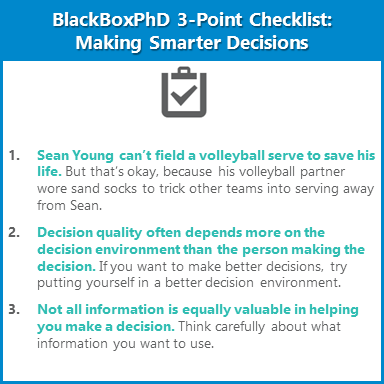
 A lot of social and cognitive psychologists study why people do dumb things, like eating until we’re stuffed, but then then eating more. Or avoiding getting tested for disease because we don’t like the name of the disease. But there’s one field that really takes pride in studying the dumb things that people do. Behavioral economics. The psychologists and economists in this field are also some of the smartest researchers in the world. One example is Danny Oppenheimer. He’s a cognitive psychologist who studies how people make decisions, especially ones that are comically irrational. He’s a Professor of Psychology and Marketing at UCLA. Prior to that he was a Professor of Psychology and Public Affairs at Princeton University. He’s received awards for being a top teacher, as well as the Ig Nobel Prize for Research that Makes you Laugh. He also wrote a popular book on the Science of Giving. We caught up last week to do one of his favorite hobbies, eat chocolate chip cookies. When I asked him to do the interview he warned me that the answers to this interview (like the answers he has discovered in the rest of life) would relate to chocolate chip cookies. In this week’s interview, he’ll teach you about people’s decisions, especially the ones we make that are really dumb. He’ll also teach all of us how to be a little smarter.
A lot of social and cognitive psychologists study why people do dumb things, like eating until we’re stuffed, but then then eating more. Or avoiding getting tested for disease because we don’t like the name of the disease. But there’s one field that really takes pride in studying the dumb things that people do. Behavioral economics. The psychologists and economists in this field are also some of the smartest researchers in the world. One example is Danny Oppenheimer. He’s a cognitive psychologist who studies how people make decisions, especially ones that are comically irrational. He’s a Professor of Psychology and Marketing at UCLA. Prior to that he was a Professor of Psychology and Public Affairs at Princeton University. He’s received awards for being a top teacher, as well as the Ig Nobel Prize for Research that Makes you Laugh. He also wrote a popular book on the Science of Giving. We caught up last week to do one of his favorite hobbies, eat chocolate chip cookies. When I asked him to do the interview he warned me that the answers to this interview (like the answers he has discovered in the rest of life) would relate to chocolate chip cookies. In this week’s interview, he’ll teach you about people’s decisions, especially the ones we make that are really dumb. He’ll also teach all of us how to be a little smarter.Hey Danny, can you tell us your background and what you’re studying?
I have a wide range of studies, but the bulk of my research tries to understand what information we use when we make judgments and decisions. For example, imagine you’re trying to decide how many cookies to eat for dessert. There are a lot of potentially useful pieces of information: e.g., how hungry you are, how many calories there are in each cookie, how good the cookies taste, etc. But there are also a lot of things that aren’t as relevant: e.g. your shoe size, whether you’ve recently gotten a haircut, what’s on television right now, etc. One of the main questions I look at is how we can distinguish the relevant information from the irrelevant information. How do we know what information should play a role in our decision, and how much should each piece of information count?
A better understanding of how people use information in making decisions can help us better support those decisions by providing the right information in the right ways. It has relevance to marketing (my current appointment) as well as public policy, health care, law, education, and daily life.
How is behavioral decision-making different from other areas of psychology? Behavioral economics is a hot term that people are starting to learn. Is behavioral decision making the same thing as behavioral economics?
Behavioral decision making is what psychologists called behavioral economics before the economists realized that it was really useful and started doing it too – because they came from economics, they called it behavioral economics. But they are two sides of the same coin. Folks with a psychology background like myself tend to focus a little more on what is going on in the minds of the decision makers, while folks from economics tend to focus a little more on the behavioral outcomes of the decision makers. But really, if you look at lists of the most prominent behavioral economists, about half of them are trained in psychology, and if you look at behavioral decision theorists, about half are trained in economics.
Let’s get into the decisions that people make? Can you tell us about your research and any funny stories of what people do?
Sure. I’ve done some work showing that people believe things that are easy to process are more valuable. So, people will pay more for stocks from companies with easy to pronounce names, will pay more for products listed in an easy to read font, and even think that less common forms of currency (e.g. $2 bills) are less valuable than economically equivalent but more common forms of currency (e.g. two $1 bills). Obviously $2 is $2 regardless of which particular bill you use, but people treat different bills as though they are different.
Why do people do that? We joke on here that it’s because people are dumb, but are the reasons why people do things that seem dumb? For example, during our graduate school sand volleyball tournament, you wore sand socks. The sand wasn’t very hot, your socks looked funny, and we still lost the tournament. That was dumb. Why did you do that?
First off, the sand WAS hot. You’re just jealous that you didn’t think of it first. Besides, if it was so embarrassing, then why were you my beach volleyball partner all those years?
But to answer your primary question, people do things that look dumb because there’s no such thing as a perfect decision making strategy. No matter what you do, you’re going to get things wrong. The job of the decision maker is to come up with strategies that will be wrong as infrequently as possible. My job is to find those infrequent situations and make the process look stupid.
I don’t do that just for kicks. The best way to see how something works, and to help it work more effectively, is to find out when it breaks down. When a person gets an answer right, one explanation is that they actually knew the answer. But when they get the answer wrong, it is really informative: there are many ways a person can err, and seeing which type of error a person makes tells us a lot about what they’re doing.
Going back to your volleyball example, when you’re playing a team you’ve never played before, and you have to decide which player we want to serve to, you might choose to serve it to the guy wearing the dorky looking sand socks. After all, folks wearing dorky looking sand socks tend to be rather un-athletic and so targeting such a person would typically give you a competitive edge. But in our case, what with your tendency to shank the serve, our opponents would have been much better off serving it your way. What is normally a good and helpful decision strategy (serving the guy in sand socks) turned out to be a mistake. By understanding the decision strategies of our opponents, I was able to trick them into tactical errors by wearing sand socks. Plus, that way I didn’t burn my feet on the sand.
Can we (people) overcome the irrational and biased decisions we make? What can we do to make smarter decisions?
The effectiveness of our decisions probably depends a lot more on the decision environment than on the people making the decisions. That is, there are some decisions that are really hard to make – we don’t have enough useful information, or the useless information looks like it’s useful (even though it’s not), or there are time constraints that mean we don’t have enough time to consider all the information etc.
decisions. That is, there are some decisions that are really hard to make – we don’t have enough useful information, or the useless information looks like it’s useful (even though it’s not), or there are time constraints that mean we don’t have enough time to consider all the information etc.
So, if we really want to make good decisions, we need to get ourselves into decision environments that maximize our chance of being effective decision makers. It’s sort of like dieting – it’s easy to diet when your refrigerator is full of vegetables than when its full of desserts. The environment can help or hinder your ability to be successful.
There’s an emerging field called ‘decision architecture’ in which researchers are developing ways to create better decision environments. Setting up choices in ways that make the trade-offs more obvious, and highlight the most useful information, and otherwise structure decisions in ways that help people choose effectively. I think in the next decade or so we’re going to see a lot more decision architecture to help support people when we make decisions.
Based on research, what are some concrete examples of things that doctors or patients could do to improve doctor-patient communication or improve patient health behaviors?
I’ll use an example from some research the two of us did together. People are often a bit vague when communicating information, which can lead to misunderstandings. So, when a doctor tells you to take a medication, and mentions that “side effects may include…” what are the odds that you actually experience side effects? The problem here is that the phrase “side effects may include” could mean anything from “there exists one person who once experienced this side effect” to “almost everybody who takes this drug experiences this side effect”. The ambiguity makes it really hard to use the information effectively – its not a very good decision environment.
So, if the doctor were to give something a bit more concrete and understandable, for example “your odds of experiencing this side effect from taking this medication are roughly the same as your odds of getting this side effect from eating a chocolate chip cookie”, it would vastly improve the decision environment, and help patients make more intelligent decisions about medication usage.

Pingback: panselnas
Pingback: Petplay
Pingback: good seedbox
Pingback: pemandangan
Pingback: roofer
Pingback: !/#Bodentrampolin
Pingback: poker online
Pingback: sscn.bkn.go.id 2018
Pingback: how to make money with a iphone
Pingback: coehuman Diyala
Pingback: Klinik gigi jakarta utara
Pingback: DMPK CRO
Pingback: Chemistry Outsourcing
Pingback: GVK BIO
Pingback: http://www.guaranteedppc.com
Pingback: guaranteed adword conversion rate
Pingback: green coffee
Pingback: pendaftarancpns2018
Pingback: hombre fit
Pingback: Array Questions
Pingback: exercices fessiers efficaces
Pingback: wardrobes sale
Pingback: C++ Tutorial
Pingback: the sports physio
Pingback: predict the absorption of orally administered drugs
Pingback: bennie macs on 1st llc
Pingback: tamoxifen side effects
Pingback: Good guy
Pingback: hoverboard
Pingback: regalos
Pingback: jadwal pembukaan cpns 2018
Pingback: informasi cpns 2018
Pingback: view website
Pingback: College
Pingback: this content
Pingback: milk production process
Pingback: investigate this site
Pingback: use this link
Pingback: new casinos NZ
Pingback: click
Pingback: bodybuilding accessories
Pingback: krwawienie
Pingback: freshamateurs755 abdu23na9796 abdu23na97
Pingback: klocki lego friends latarnia morska
Pingback: sildenafil effects
Pingback: wdyzgkah
Pingback: amoxicillin 500 cost
Pingback: lasix 20 mg pill
Pingback: zithromax pill
Pingback: cost of ivermectin pill
Pingback: albuterol asthma
Pingback: armour vs synthroid
Pingback: propecia 1mg
Pingback: neurontin and klonopin
Pingback: metformin and alcohol
Pingback: plaquenil generic brand
Pingback: buy amoxicilin online
Pingback: furosemide cost usa
Pingback: buy gabapentin 300mg
Pingback: quineprox 0.4
Pingback: prednisone no rx
Pingback: avana 100 in india
Pingback: 400 mg modafinil
Pingback: buy ivermectin cream
Pingback: albuterol 200 mcg
Pingback: zithromax
Pingback: hydroxychloroquine 2
Pingback: buy 40 mg prednisone
Pingback: priligy 60mg
Pingback: zithromax pills
Pingback: aralen cost uk
Pingback: baricitinib lilly
Pingback: lumigan drops
Pingback: nolvadex usa
Pingback: olumiant tablet